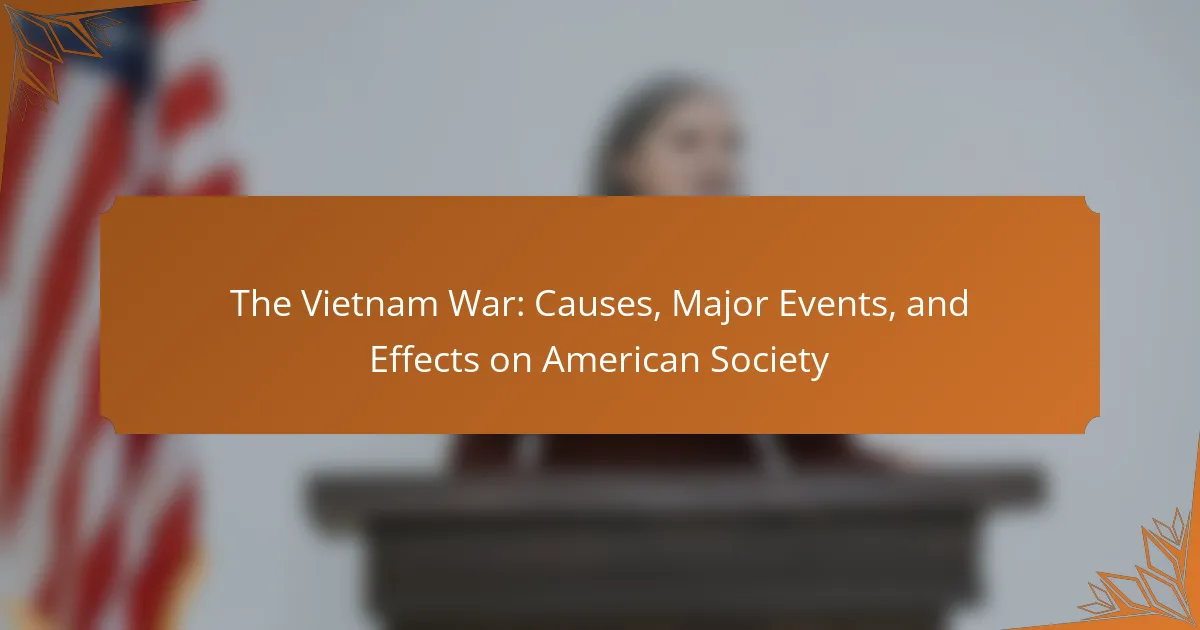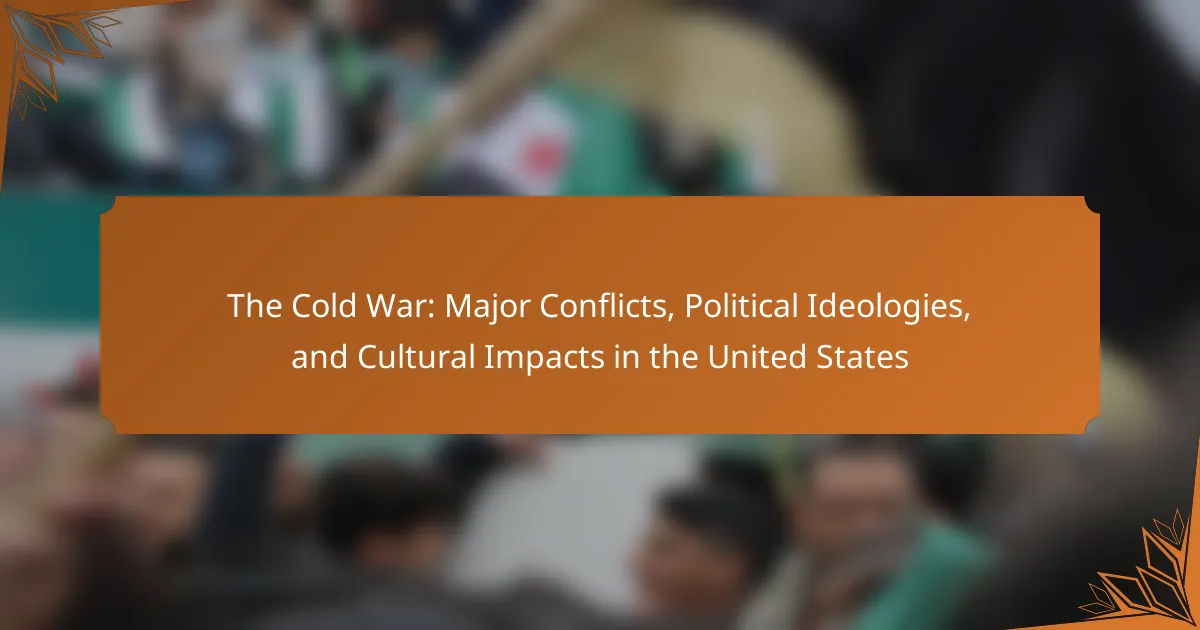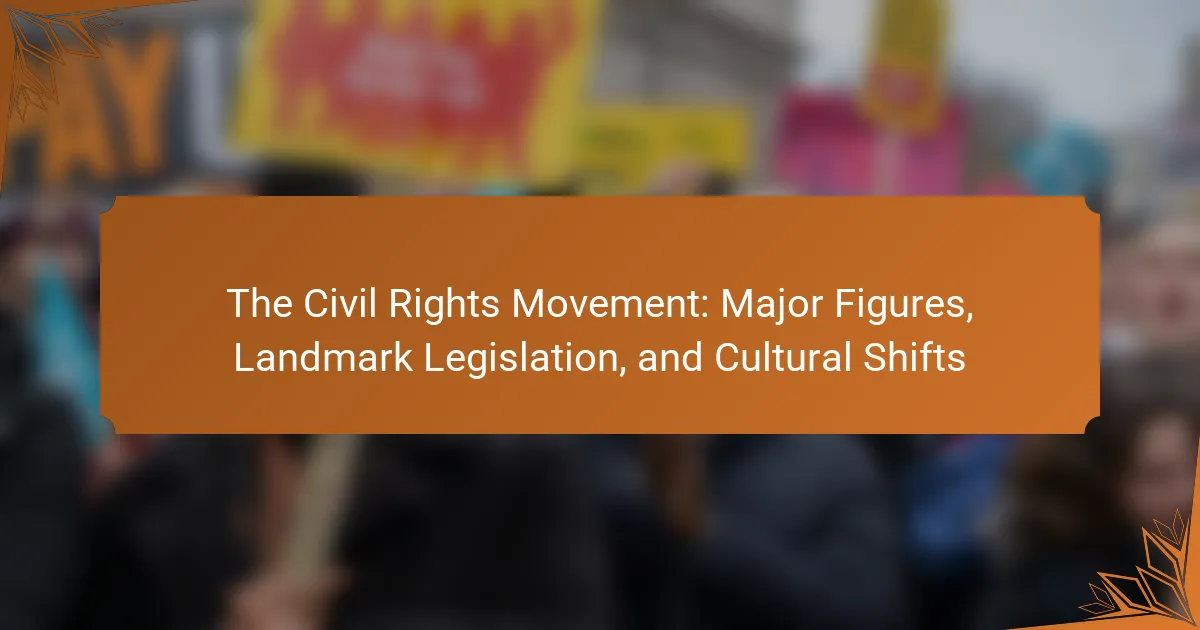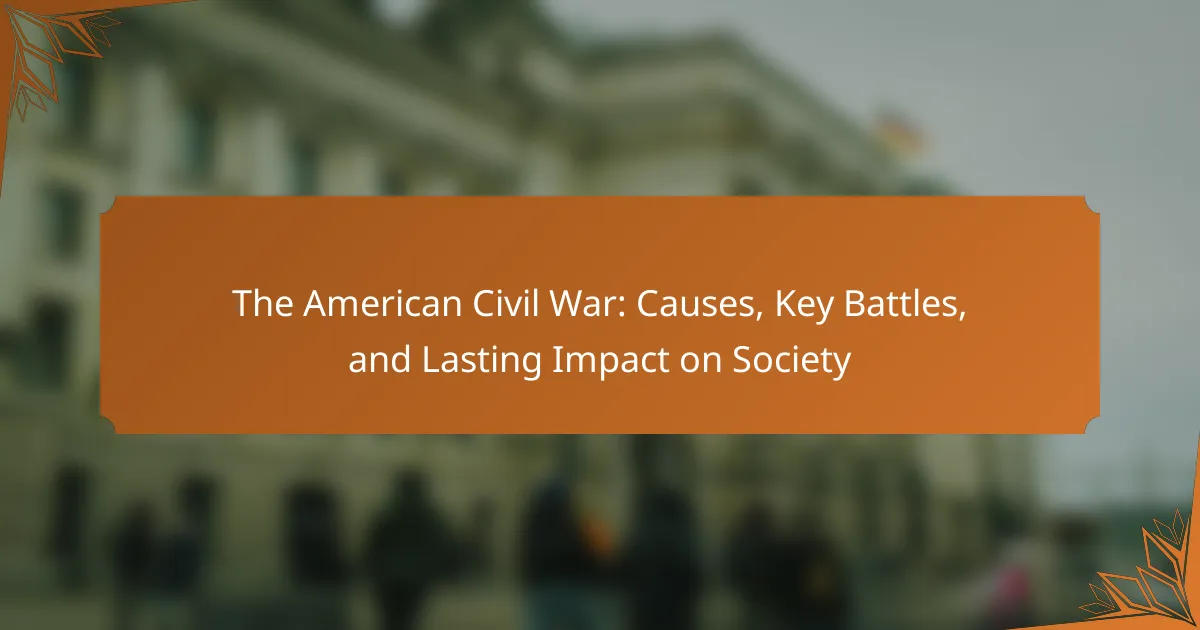The Vietnam War was a complex conflict driven by the spread of communism, U.S. foreign policy objectives, and a history of colonialism. Key events such as the Gulf of Tonkin Incident, the Tet Offensive, and the My Lai Massacre significantly escalated U.S. involvement and shaped public perception. The war led to widespread protests and a counterculture movement in American society, resulting in political divisions and a decline in trust towards the government. Ultimately, the Vietnam War had profound effects on American culture, politics, and social attitudes, culminating in the reunification of Vietnam in 1975.
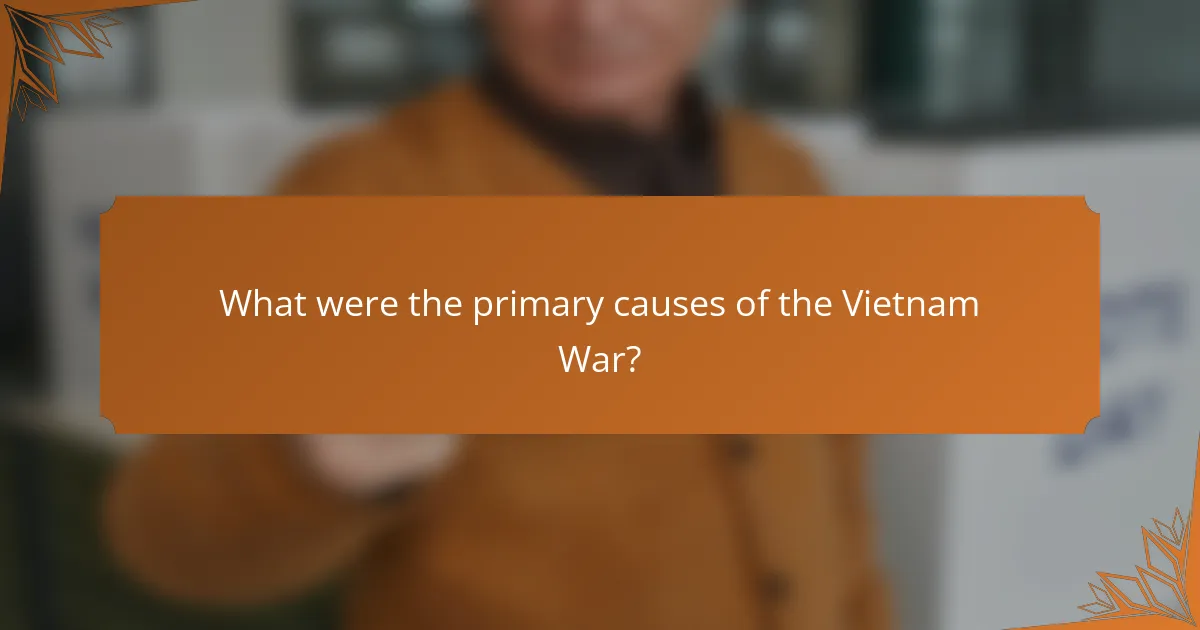
What were the primary causes of the Vietnam War?
The primary causes of the Vietnam War include the spread of communism, U.S. foreign policy, and colonial history. The Cold War context fueled fears of a domino effect in Southeast Asia. The U.S. aimed to contain communism, supporting South Vietnam against the communist North. The Geneva Accords of 1954 temporarily divided Vietnam, leading to tensions. Additionally, the desire for independence from colonial rule contributed to conflict. The Gulf of Tonkin incident in 1964 escalated U.S. involvement significantly. These factors combined created a complex environment that led to the war.
How did historical context contribute to the Vietnam War?
The historical context significantly contributed to the Vietnam War by shaping its political and social landscape. The Cold War rivalry between the United States and the Soviet Union influenced U.S. involvement in Vietnam. The spread of communism in Southeast Asia raised concerns for U.S. policymakers. The U.S. aimed to contain communism, following the Domino Theory, which suggested that if one country fell to communism, neighboring countries would follow.
Vietnam’s colonial history under French rule created a backdrop of resistance and nationalism. The Geneva Accords of 1954 divided Vietnam into North and South, escalating tensions. The North, supported by the Soviet Union and China, aimed for reunification under a communist government. The U.S. backed the South, fearing the loss of influence in the region.
The Gulf of Tonkin incident in 1964 marked a turning point, leading to increased military engagement. Historical context, including colonialism, Cold War dynamics, and regional nationalism, directly influenced the escalation and nature of the Vietnam War.
What role did colonialism play in the lead-up to the conflict?
Colonialism significantly contributed to the lead-up to the Vietnam War. French colonial rule in Vietnam from the mid-19th century to World War II fostered resentment among the Vietnamese people. The harsh policies imposed by the French exploited local resources and suppressed Vietnamese culture. During World War II, Japan occupied Vietnam, further complicating the colonial legacy. After the war, the struggle for independence intensified, leading to the First Indochina War against French colonial forces. The defeat of the French at Dien Bien Phu in 1954 marked a pivotal moment, leading to the Geneva Accords and the division of Vietnam. This colonial history set the stage for subsequent conflict, as nationalist movements sought to unify Vietnam and reject foreign domination.
How did the Cold War influence American involvement in Vietnam?
The Cold War significantly influenced American involvement in Vietnam. The United States aimed to contain the spread of communism during this period. American leaders viewed Vietnam as a critical battleground in the fight against communism. The domino theory suggested that if one country fell to communism, neighboring countries would follow. This belief prompted the U.S. to support the French in their fight against the Viet Minh. After France’s defeat, the U.S. increased military and economic aid to South Vietnam. By the early 1960s, U.S. military presence escalated with the deployment of combat troops. The Cold War context framed Vietnam as essential to U.S. national security interests.
What were the key political and social factors that ignited the war?
The key political and social factors that ignited the Vietnam War included colonialism, nationalism, and the Cold War dynamics. French colonial rule in Vietnam created resentment among the Vietnamese population. Nationalist movements sought independence from colonial powers, leading to conflict. The rise of communism in North Vietnam heightened tensions with the U.S. and its allies. The U.S. aimed to contain communism, fearing a domino effect in Southeast Asia. Social factors included the influence of anti-colonial sentiment and the desire for self-determination among the Vietnamese people. These factors culminated in military involvement by the U.S. following the Gulf of Tonkin incident in 1964. This incident was a pivotal moment that escalated U.S. military presence in Vietnam.
How did the division of Vietnam affect the conflict’s onset?
The division of Vietnam into North and South significantly influenced the conflict’s onset. This division occurred in 1954 after the Geneva Accords. North Vietnam, led by the communist government under Ho Chi Minh, aimed for reunification under a communist regime. Conversely, South Vietnam, supported by the United States, sought to maintain a non-communist government. The ideological clash between communism and capitalism heightened tensions. This division fostered a civil war atmosphere, as both sides aimed to assert control over the entire country. The U.S. involvement escalated due to fears of a domino effect in Southeast Asia. Thus, the division directly set the stage for the Vietnam War’s escalation.
What impact did the Domino Theory have on U.S. policy?
The Domino Theory significantly influenced U.S. foreign policy during the Cold War. It posited that if one country in a region fell to communism, neighboring countries would follow. This belief led to increased U.S. military involvement in Southeast Asia. The theory was a driving force behind the U.S. decision to support South Vietnam against the communist North. It justified the escalation of American troops in Vietnam, reaching over 500,000 by 1969. The Domino Theory also shaped the U.S. approach to other regions, promoting interventionist policies globally. This resulted in a commitment to contain communism, affecting relations with countries like Laos and Cambodia. The theory’s influence waned after the Vietnam War’s outcome, prompting a reevaluation of U.S. interventionist strategies.
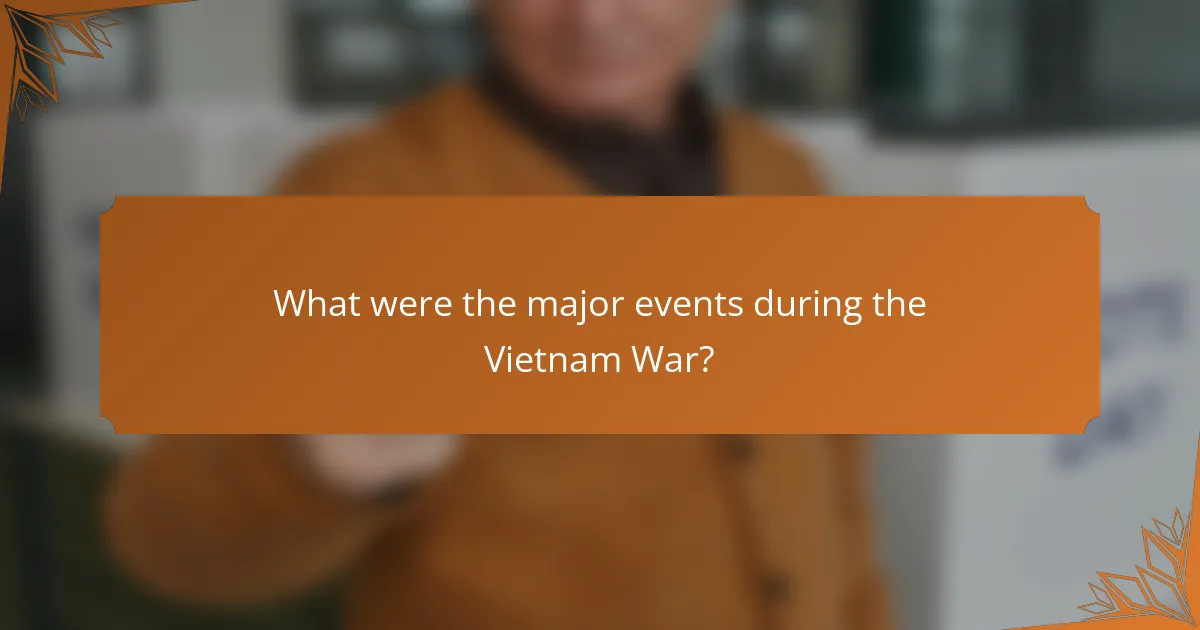
What were the major events during the Vietnam War?
The major events during the Vietnam War included the Gulf of Tonkin Incident in 1964, which escalated U.S. involvement. The Tet Offensive in 1968 was a significant turning point, showcasing the Viet Cong’s capability. The My Lai Massacre in 1968 revealed the brutal realities of war and sparked outrage. The Paris Peace Accords in 1973 aimed to establish peace and end U.S. involvement. The fall of Saigon in 1975 marked the end of the war, leading to the reunification of Vietnam. Each event significantly influenced public perception and policy regarding the war.
What significant battles and operations defined the Vietnam War?
The significant battles and operations that defined the Vietnam War include the Tet Offensive, the Battle of Dien Bien Phu, and Operation Rolling Thunder. The Tet Offensive occurred in January 1968. It was a coordinated series of attacks by North Vietnamese and Viet Cong forces. This offensive aimed to capture key cities and provoke a U.S. withdrawal. The Battle of Dien Bien Phu took place in 1954. It marked the end of French colonial rule in Indochina. The battle showcased the effectiveness of guerrilla tactics against conventional forces. Operation Rolling Thunder was a sustained bombing campaign from 1965 to 1968. It aimed to weaken North Vietnam’s capacity to wage war. These events significantly shaped public perception and military strategy during the war.
What was the importance of the Tet Offensive?
The Tet Offensive was a significant military campaign during the Vietnam War. Launched in January 1968, it involved surprise attacks by North Vietnamese and Viet Cong forces on South Vietnamese cities and military targets. The offensive aimed to undermine U.S. public support for the war. Despite heavy casualties for the attackers, it shifted American perceptions of the war. The media coverage revealed the stark contrast between official government statements and the realities on the ground. This led to growing anti-war sentiment in the United States. The Tet Offensive marked a turning point in U.S. involvement in Vietnam. It ultimately contributed to a change in U.S. military strategy and policy.
How did the My Lai Massacre affect public perception?
The My Lai Massacre significantly altered public perception of the Vietnam War. It exposed the brutal realities of U.S. military actions. The massacre, occurring in March 1968, involved the killing of approximately 500 unarmed Vietnamese civilians. News of the event surfaced in 1969, leading to widespread outrage. Graphic images and reports intensified anti-war sentiment across the United States. The incident undermined trust in the government and military leadership. It prompted protests and increased calls for troop withdrawal. The My Lai Massacre became a symbol of the war’s moral complexities and humanitarian crises.
What role did media coverage play during the Vietnam War?
Media coverage played a crucial role during the Vietnam War. It significantly influenced public perception and opinion about the conflict. Graphic images and reports brought the realities of war into American living rooms. This exposure led to widespread protests and a decline in support for the war. The Tet Offensive in 1968 exemplified this impact, as media coverage contradicted government claims of progress. Journalists reported on civilian casualties and the harsh conditions faced by soldiers. This coverage fostered a sense of disillusionment among the American public. Ultimately, media coverage shaped the narrative of the Vietnam War and its consequences on society.
How did television shape American views on the war?
Television significantly shaped American views on the Vietnam War by bringing the realities of combat into living rooms. Graphic images and reports from the front lines altered public perception. The broadcast of distressing footage highlighted the war’s brutality. This exposure led to increased anti-war sentiment among viewers. Polls indicated that as televised coverage intensified, opposition to the war grew. Major networks aired reports that showcased civilian casualties and suffering. These portrayals contradicted official government narratives. Consequently, television became a powerful tool for influencing public opinion on the Vietnam War.
What were the consequences of graphic reporting from the front lines?
Graphic reporting from the front lines during the Vietnam War led to significant public backlash against the war. The vivid images and stories shared by journalists highlighted the brutal realities of combat. This exposure shifted public perception, increasing anti-war sentiment across the United States. Graphic reporting also influenced political discourse, prompting debates on military strategy and ethics. As a result, the government faced mounting pressure to reconsider its involvement in Vietnam. Studies indicate that graphic media coverage contributed to the decline in public support for the war. The powerful imagery often evoked emotional responses, further galvanizing protests and demonstrations. Ultimately, graphic reporting played a crucial role in shaping the narrative surrounding the Vietnam War.
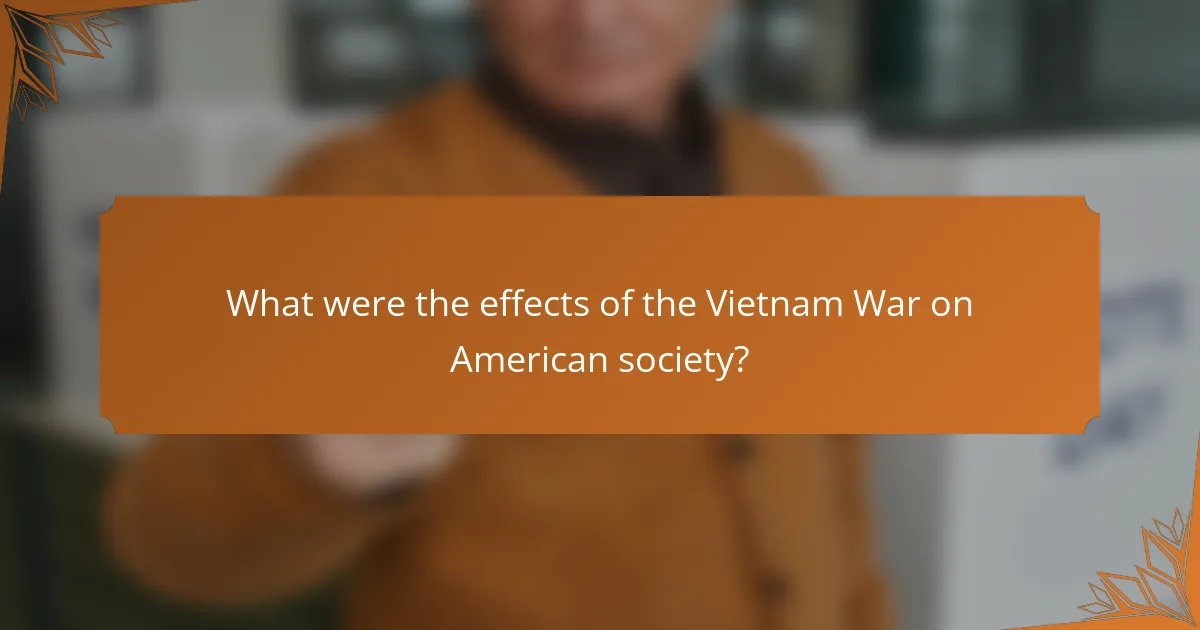
What were the effects of the Vietnam War on American society?
The Vietnam War significantly impacted American society. It led to widespread protests and a counterculture movement. Many Americans opposed the war, leading to a rise in anti-war demonstrations. The conflict also caused deep political divisions within the country. Trust in government decreased as the public became disillusioned with official narratives. The war’s toll included over 58,000 American lives lost and numerous veterans facing challenges upon returning home. Social changes emerged, including shifts in attitudes toward authority and military engagement. The media’s role expanded, influencing public perception and awareness of war realities. Overall, the Vietnam War reshaped American cultural, political, and social landscapes.
How did the Vietnam War impact American politics?
The Vietnam War significantly impacted American politics by altering public opinion and government policy. The war led to widespread protests and a growing anti-war movement. This movement influenced political discourse, making it a critical election issue. The credibility gap emerged as citizens questioned government statements about the war. The conflict also contributed to the rise of a more skeptical media landscape. Legislative changes, such as the War Powers Act of 1973, aimed to limit presidential military authority. The war’s legacy affected U.S. foreign policy for decades. Overall, it reshaped the relationship between the government and the public.
What changes occurred in U.S. foreign policy after the war?
U.S. foreign policy underwent significant changes after the Vietnam War. The war led to a more cautious approach in international engagements. The policy of containment was reevaluated, resulting in a shift towards détente with the Soviet Union. The U.S. also prioritized diplomacy over military intervention in subsequent conflicts. This period saw an increase in reliance on allies and multilateral organizations. The War Powers Act of 1973 limited presidential power to engage in military conflicts without congressional approval. Overall, the Vietnam War’s impact led to a more restrained and calculated U.S. foreign policy.
How did the war influence public trust in government?
The Vietnam War significantly eroded public trust in government. Many citizens felt misled by government officials regarding the war’s progress and justification. The Tet Offensive in 1968 contradicted optimistic government reports, leading to widespread skepticism. Protests and media coverage highlighted discrepancies between official narratives and on-the-ground realities. Polls indicated a sharp decline in approval ratings for government leaders during and after the conflict. By the early 1970s, trust in government had reached historic lows, as many Americans questioned the integrity of political institutions. This loss of trust had lasting effects on American political culture and civic engagement.
What social movements emerged as a result of the Vietnam War?
The Vietnam War led to several significant social movements in the United States. The anti-war movement gained momentum, opposing U.S. involvement in Vietnam. This movement included protests, marches, and demonstrations across the country. The civil rights movement also evolved during this period, as activists connected the struggle for racial equality with opposition to the war. The women’s liberation movement emerged, highlighting issues like gender equality and reproductive rights. Environmentalism gained traction, as activists began to address the war’s ecological impacts. These movements were fueled by widespread disillusionment with government policies and military actions. The Kent State shooting in 1970 galvanized anti-war sentiment and increased activism. Overall, the Vietnam War significantly shaped various social movements that sought change in American society.
How did anti-war protests shape American culture?
Anti-war protests significantly shaped American culture by fostering a climate of dissent and activism. These protests questioned government policies and military actions, particularly during the Vietnam War. The civil rights movement influenced many anti-war activists, linking social justice to anti-war sentiments. Public demonstrations, such as the 1969 Moratorium to End the War in Vietnam, drew millions and highlighted widespread discontent. The protests also gave rise to a counterculture that embraced alternative lifestyles, music, and art. Media coverage brought the realities of war into American homes, changing public perception. This shift contributed to a growing skepticism towards authority and government. Ultimately, anti-war protests played a crucial role in shaping a more engaged and critical American society.
What role did veterans play in advocating for social change?
Veterans played a significant role in advocating for social change during and after the Vietnam War. Many veterans became vocal critics of the war upon their return home. They organized protests and participated in anti-war movements, bringing attention to the moral implications of the conflict. Organizations like Vietnam Veterans Against the War were formed, allowing veterans to share their experiences and perspectives. Their testimonies highlighted the harsh realities of war, influencing public opinion. The Winter Soldier Investigation in 1971 showcased war crimes, further galvanizing anti-war sentiments. Veterans also fought for veterans’ rights and better mental health care, emphasizing the need for societal support. Their advocacy contributed to a broader discourse on military engagement and civil rights.
What lessons can be learned from the Vietnam War’s impact on society?
The Vietnam War taught significant lessons about the consequences of military intervention. One key lesson is the importance of public opinion in shaping government policy. The widespread protests against the war highlighted how citizen dissent can influence decision-making. Another lesson is the need for clear communication and transparency from leadership. Misinformation during the war eroded trust in government institutions. Additionally, the war underscored the psychological impact of conflict on veterans and society. Many returning soldiers faced mental health challenges, emphasizing the need for support systems. The Vietnam War also illustrated the complexities of foreign policy and the potential for unintended consequences. These lessons continue to inform current military and diplomatic strategies.
How can understanding the Vietnam War inform current military engagements?
Understanding the Vietnam War provides critical lessons for current military engagements. The Vietnam War highlighted the importance of public support for military actions. High casualty rates and unclear objectives led to widespread protests in the United States. This illustrates the need for transparent communication with citizens. Additionally, the war demonstrated the challenges of asymmetric warfare. Non-traditional tactics used by the Viet Cong were effective against a conventional military force. Current military strategies must consider these tactics in modern conflicts. The Vietnam War also emphasized the significance of cultural awareness. Understanding local sentiments can influence the success of military operations. Historical analysis shows that ignoring these lessons can lead to repeated mistakes in future engagements.
What are the best practices for addressing the legacy of the Vietnam War in education?
Incorporating the legacy of the Vietnam War in education requires a multifaceted approach. Educators should utilize primary sources, including photographs and letters, to provide firsthand perspectives. This practice fosters critical thinking and personal connection to historical events. Engaging students in discussions about the war’s impact on American society encourages diverse viewpoints. Curriculum should include the voices of veterans and anti-war activists to present a balanced narrative. Integrating literature and films from the period can enhance understanding of the cultural context. Field trips to museums or historical sites can provide experiential learning opportunities. Finally, promoting reflective assignments allows students to process and articulate their thoughts on the war’s legacy. These practices contribute to a comprehensive understanding of the Vietnam War’s complexities.
The Vietnam War serves as the primary entity of this article, which explores its causes, major events, and effects on American society. Key factors leading to the war include the spread of communism, U.S. foreign policy, and Vietnam’s colonial history, with significant events such as the Gulf of Tonkin incident and the Tet Offensive marking critical turning points. The article also examines the impact of the war on American politics, public trust in government, and the emergence of various social movements, highlighting the lasting lessons learned from this complex conflict.
